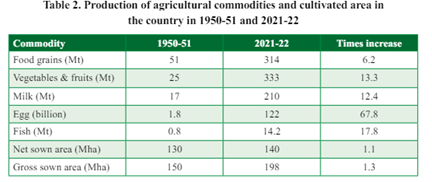Introduction
India is one of the major players in the agriculture sector worldwide and it is the primary source of livelihood for about 55% of India’s population with a share of 41% in total employment (2020). It has about 160 million hectares (Mha) of arable land, second largest after the United States of America. Thus, farmers become an integral part of the sector to provide us with a means of sustenance. India is the world’s 2nd largest producer of food grains, fruits and vegetables and the 2nd largest exporter of sugar.
Indian Agriculture – Before Independence
Before India gained independence in 1947, its agriculture was characterised by a blend of traditional practices, colonial influences, and varied regional dynamics. The various phases include:
1. Ancient and Medieval Periods
-
- Indus Valley Civilization (3300–1300 BCE): Early agricultural practices with crops like wheat, barley, and cotton.
- Maurya and Gupta Empires: Innovations in irrigation and farming techniques. Spread of rice cultivation in Eastern India.
- Medieval India: Introduction of new crops like sugarcane, and advancements in water management systems like tanks and wells.
2. Colonial Period (1757-1947)
-
- British East India Company and the Crown: Post the Battle of Plassey (1757), British control expanded, deeply impacting Indian agriculture.
- Commercialisation: Shift from subsistence farming to cash crop production (indigo, opium, tea, and cotton) to meet colonial needs.
- Land Revenue Systems: Introduction of systems like Zamindari, Ryotwari, and Mahalwari, which altered traditional land ownership and exacerbated peasant indebtedness.
Indian Agriculture since Independence
The progress of Indian agriculture has been quite impressive despite several limiting factors such as uncertainties of weather, declining soil health, increasing temperature and emergence of virulent pest and pathogens. It is the toiling work of millions of our farmers, scientists and the planners that transformed India from a food deficit country to a food surplus and net food exporter nation. The food grain production, which was merely 51 million tons (Mt) in 1950/51 increased over 6 times to over 325 Mt in 2023.


